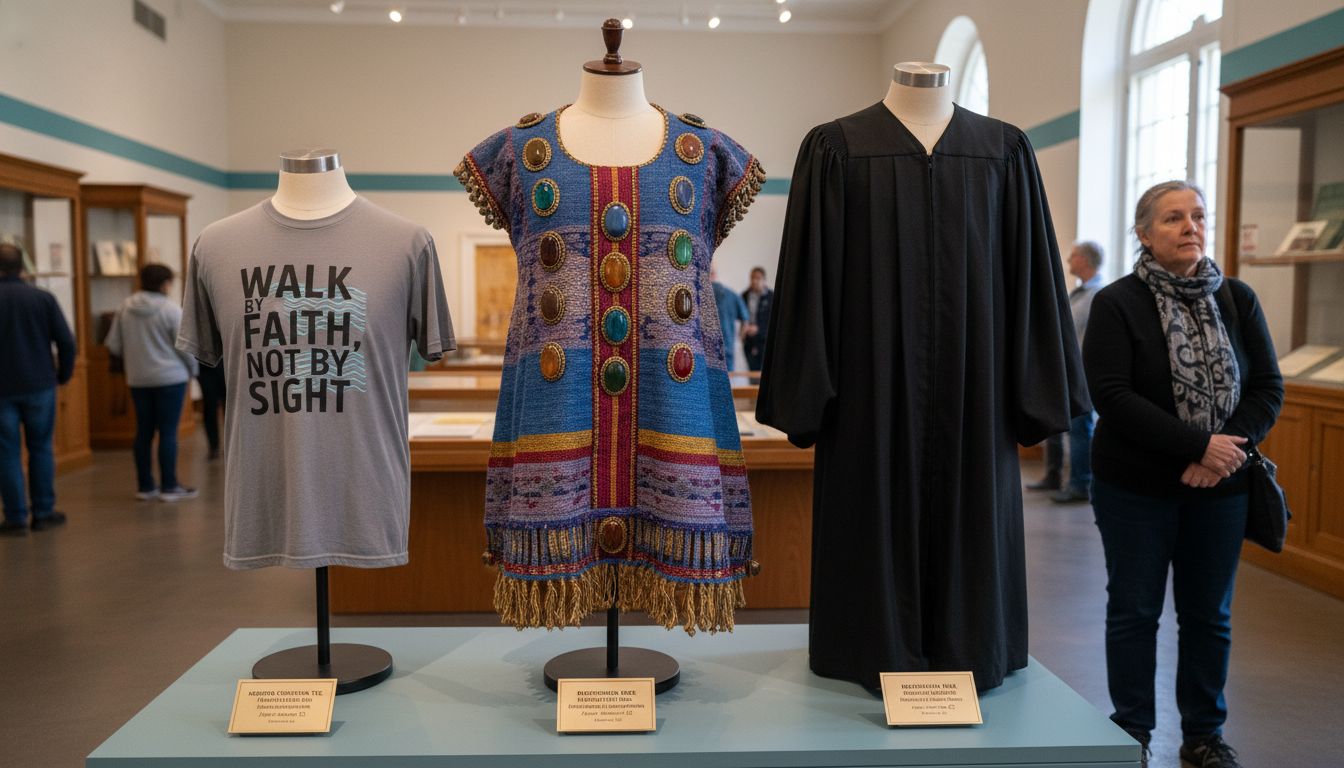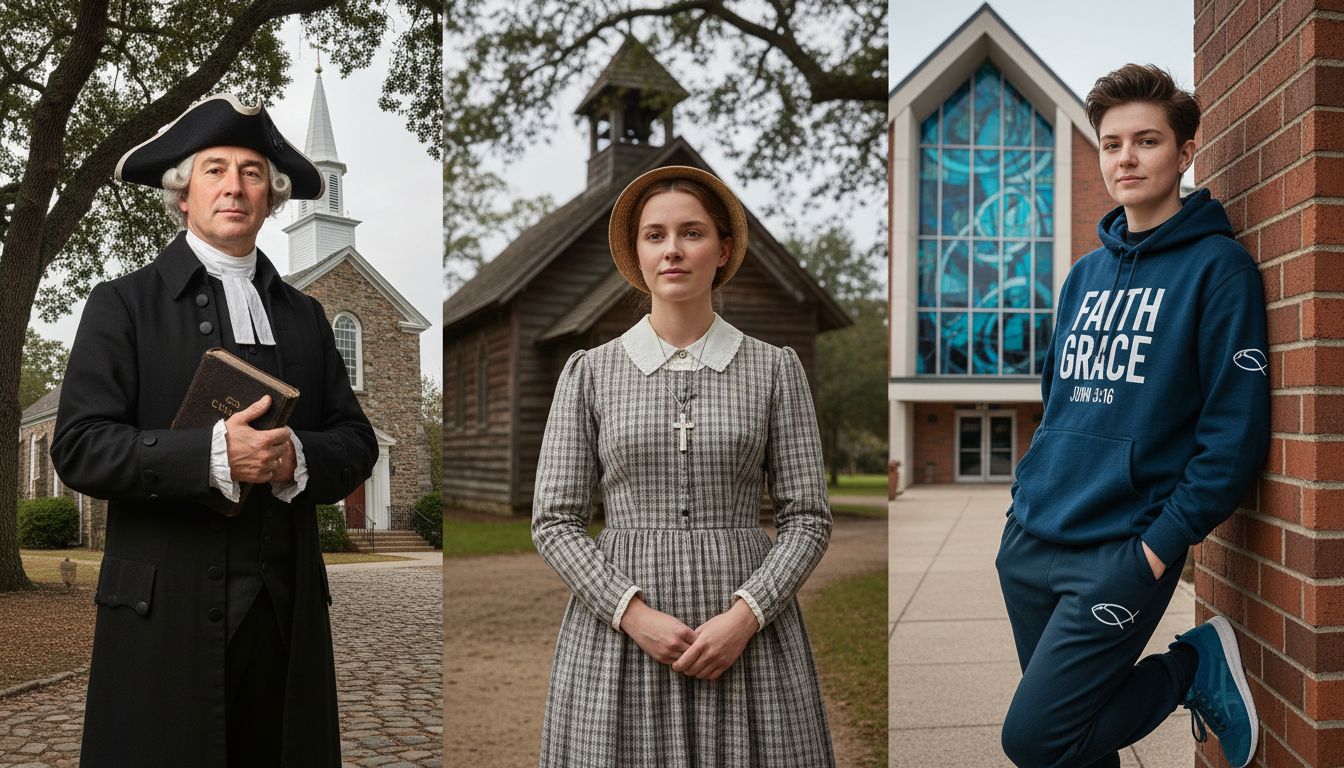Did you know that sacred vestments in the Bible served as visible signs of spiritual transformation, not just religious dress? For centuries, garments in scripture carried astonishing meaning, with priestly attire symbolizing salvation and divine glory. Clothing choices spoke to personal faith, societal status, and the human journey from sin to righteousness. This intricate world reveals how fabric, color, and design became powerful spiritual language shaping identity and belief across generations.
Table of Contents
- Biblical Garments And Their Meanings
- Evolution Of Clerical Vestments Over Centuries
- Lay Christian Attire And Symbolic Apparel
- Modern Christian Fashion And Streetwear
Key Takeaways
| Point | Details |
|---|---|
| Biblical Garments as Symbols | Biblical garments convey profound spiritual meanings related to transformation, redemption, and humanity’s connection with God. |
| Evolution of Clerical Vestments | Clerical garments reflect historical and theological changes, evolving from simple to elaborate designs that signify spiritual identity and authority. |
| Lay Christian Attire | Christian clothing serves as a medium for expressing faith and values, with an emphasis on modesty, symbolism, and cultural expression. |
| Modern Christian Fashion | Contemporary Christian fashion blends bold messaging with current trends, allowing believers to express their faith creatively and authentically. |
Biblical Garments And Their Meanings
Biblical garments represent far more than simple fabric and threads - they are profound spiritual symbols conveying deep theological messages about transformation, redemption, and humanity’s relationship with God. Sacred vestments in biblical contexts carried extraordinary significance, functioning as visual metaphors for spiritual realities that transcended their physical appearance.
According to research from Brigham Young University Scholars Archive, ancient sacred vestments worn by high priests symbolized critical spiritual concepts including salvation, righteousness, and divine glory. These ceremonial garments were not merely decorative but served as powerful transitional elements that moved individuals from profane spaces into sacred encounters with the divine.
The biblical narrative consistently uses clothing imagery to communicate profound spiritual truths. From the moment God crafted animal skin coverings for Adam and Eve after their fall, garments represented spiritual transformation. As research from Andrews University indicates, clothing in scripture symbolizes humanity’s journey from sinfulness to righteousness through divine grace.
Key symbolic representations of biblical garments include:
Here’s a comparison of key symbolic aspects of biblical garments:
| Symbolic Meaning | Description | Example from Scripture |
|---|---|---|
| Covering of Sin | God’s mercy and provision | Adam & Eve’s coverings |
| Righteousness | Spiritual purity and restoration | Priestly garments |
| Transformation | Journey of redemption | Joseph’s coat of many colors |
| Identity | Spiritual status and relationship with God | High priest’s ephod |
- Covering of Sin: Representing God’s provision and mercy
- Righteousness: Symbolizing spiritual purity and restoration
- Transformation: Depicting the believer’s journey of redemption
- Identity: Reflecting one’s spiritual status and relationship with God
Evolution Of Clerical Vestments Over Centuries
Clerical vestments have been a dynamic reflection of spiritual identity, cultural context, and theological understanding throughout Christian history. These sacred garments have transformed dramatically, serving not just as clothing but as powerful symbols of ecclesiastical authority and spiritual representation.
According to research from Concordia Seminary, liturgical vestments underwent significant evolution as early Christian clergy adopted garments that symbolized their unique roles and spiritual significance. These vestments were more than aesthetic choices - they represented a profound connection between the wearer’s spiritual mission and their visual presentation within religious communities.
During the Reformation, the Lutheran Church demonstrated a remarkable approach to vestment design. Research from Concordia Theological Monthly reveals that Lutherans retained traditional clerical attire while simultaneously reforming them to align with emerging theological principles. This balanced approach preserved historical continuity while ensuring that vestments remained spiritually meaningful and theologically authentic.
Key transformations in clerical vestments throughout history include:
- Early Church Period: Simple, functional garments representing humility
- Medieval Era: Increasingly elaborate vestments signaling hierarchical status
- Reformation Period: Streamlined designs emphasizing theological purity
- Modern Era: Diverse styles reflecting global cultural and denominational variations
Lay Christian Attire And Symbolic Apparel
Christian clothing has always been more than mere fabric - it’s a profound expression of spiritual identity, belief, and cultural connection. Throughout history, believers have used attire as a powerful medium to communicate their faith, values, and theological commitments.
Research from Brigham Young University reveals fascinating insights into early Christian textile symbolism. Ancient Jewish and Christian garments featured gammadia, unique symbolic markings dating before A.D. 73 that represented religious hopes and spiritual convictions. These intricate symbols demonstrate how clothing functioned as a visual language of faith, transcending mere aesthetic choices.

According to research from University of Denver, clothing in ancient Israel held deep religious significance. High priests’ garments, crafted from fine materials, weren’t just ceremonial attire but powerful statements of consecration and spiritual status. For contemporary Christians, this tradition continues - clothing becomes a meaningful way to express devotion and spiritual identity.
Key aspects of lay Christian attire include:
- Modesty: Reflecting inner spiritual values
- Symbolism: Incorporating faith-based imagery and messages
- Cultural Expression: Balancing personal style with spiritual authenticity
- Witness: Using clothing as a subtle form of evangelical communication
Learn more about the deeper meanings behind Christian clothing in our guide on what makes apparel Christian.
Modern Christian Fashion And Streetwear
Christian fashion has dramatically transformed, evolving from traditional liturgical attire to contemporary streetwear that boldly expresses faith in modern urban contexts. Spiritual style now bridges the gap between personal belief and cultural expression, allowing believers to wear their convictions with authenticity and creativity.
Research from Harvard Undergraduate Art History Journal highlights how religious textiles have always been more than mere clothing - they are powerful mediums of theological communication. Armenian liturgical textiles demonstrate how intricate designs can convey complex spiritual narratives, a tradition now reimagined in contemporary Christian streetwear.
According to Spencer Art Museum, liturgical garments like the chasuble symbolize deeper spiritual meanings, representing Christ’s protective love and the community’s theological identity. Modern Christian streetwear similarly transforms clothing into a statement of faith, using design, imagery, and messaging to communicate spiritual values in an increasingly visual culture.
Key characteristics of modern Christian fashion include:
- Bold Messaging: Incorporating scripture and faith-based graphics
- Contemporary Design: Merging current fashion trends with spiritual themes
- Witnessing Through Style: Using clothing as a conversation starter
- Authentic Expression: Reflecting personal spiritual journey
Discover more about the evolution of faith-based fashion in our guide to understanding Christian fashion.
Step Into Your Faith With Meaningful Christian Apparel
Understanding the rich history of Christian clothing reveals the deep spiritual significance behind every garment. Whether it is the symbolic transformation found in biblical vestments or the modern expression of faith through style, many believers seek clothing that not only reflects their identity but also connects them to centuries of spiritual tradition. Too often, finding apparel that truly embodies these values can feel challenging.
At Walk In His Footsteps, we solve this by offering faith-inspired footwear that carries centuries of symbolic meaning. Our patented cross bottom and Jesus fish bottom slip-on shoes are designed to be more than just footwear. They are a wearable declaration of your spiritual journey and identity. Imagine stepping confidently into your day with shoes that echo the profound biblical messages of righteousness and transformation you have just learned about.

Discover a unique way to express your faith through apparel that honors tradition and embraces modern style. Take your first step toward authentically wearing your beliefs by visiting Walk In His Footsteps. Embrace clothing that speaks volumes about who you are in Christ today and experience the powerful blend of history and purpose in every pair.
Learn more about the meaning behind what you wear in our insights on what makes apparel Christian and explore the evolution of faith-expression in Christian fashion through our guide to understanding Christian fashion. Start walking your path boldly now.
Frequently Asked Questions
What is the significance of biblical garments in Christian tradition?
Biblical garments symbolize spiritual concepts such as salvation, righteousness, and transformation, serving as visual metaphors for humanity’s relationship with God.
How have clerical vestments evolved throughout Christian history?
Clerical vestments have transformed from simple garments in the Early Church to elaborate designs in the Medieval Era, then to streamlined styles during the Reformation, and now to diverse expressions in the Modern Era, reflecting spiritual identities and theological principles.
What role does lay Christian attire play in expressing faith?
Lay Christian attire represents spiritual identity and cultural connection, with aspects like modesty, symbolism, and cultural expression being important in communicating one’s beliefs and values through clothing.
How has modern Christian fashion incorporated traditional elements?
Modern Christian fashion merges traditional liturgical attire with contemporary streetwear, using bold messaging and design to reflect faith and spirituality while appealing to current trends.
Recommended
- Understanding Christian Clothing Stores: Faith and Fashion – Walk In His Footsteps
- Understanding Why Christian Clothing Matters for Believers – Walk In His Footsteps
- Understanding Christian Clothing: Significance and Styles – Walk In His Footsteps
- Understanding the Christian Clothing Company and Its Values – Walk In His Footsteps
- Complete Guide to Fair Trade Women’s Clothing – WorkWearComfort




